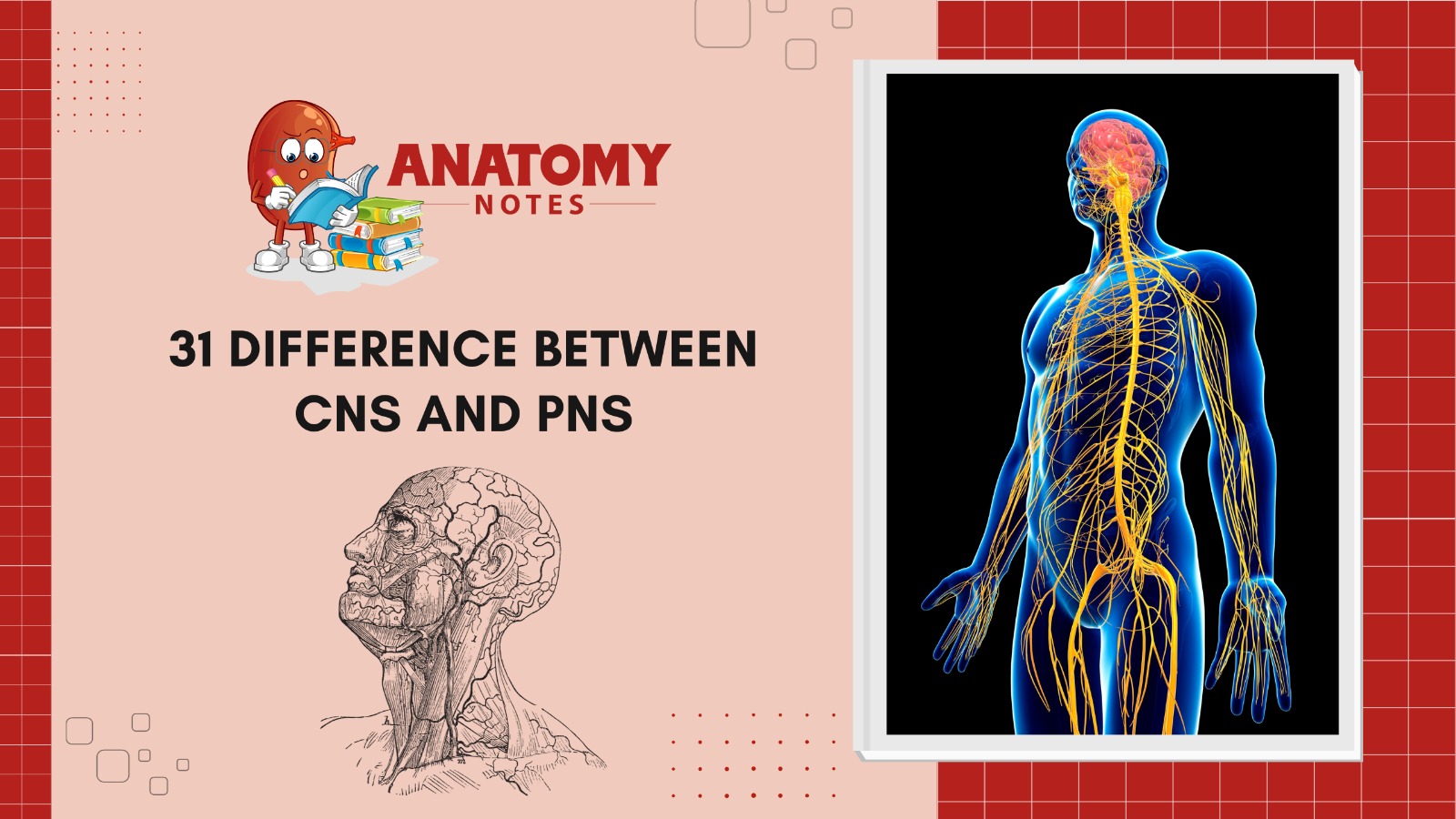The human central nervous system (CNS) and peripheral nervous system (PNS) regulate physiological processes and reactions to environmental stimuli. Despite being related, these systems differ in structure, function, and body placement. The CNS—the brain and spinal cord—commands the nervous system. Processing information, making decisions, and coordinating body processes depend on it. Nerves and ganglia throughout the body form the PNS, which communicates with the CNS. One major difference between the two systems is location.
The CNS and PNS vary in sensory and motor functions. Although the CNS handles sensory integration, decision-making, and motor control, the PNS transmits sensory information from the periphery to the CNS and executes motor orders from the CNS to the muscles and glands. This separation of work guarantees efficiency and quick environmental reaction. The CNS is housed in the skull and spinal column. Due to its lack of protection, the PNS is more vulnerable to injury. CNS relevance and susceptibility are highlighted by this protective gap.
Additionally, these systems’ cells vary. For processing and delivering information, CNS neurons are mostly interneurons. However, sensory neurons send messages to the CNS and motor neurons send orders to muscles and glands in the PNS. Cellular differentiation emphasizes each system’s unique functions. The two systems’ regeneration capacity also differs. Due to their superior regeneration capabilities, PNS neurons help peripheral nerve damage repair. Brain and spinal cord injury recovery is harder because CNS neurons are less regenerative.
Ultimately, the CNS and PNS are vital parts of the nervous system with separate functions. Although the CNS is the body’s primary command center, the PNS is its communication network. Both systems help us detect, process, and respond to the world, but their distinctions in location, function, protection, cellular composition, and regeneration potential show their complexity and complementarity.
|
S.No. |
Aspect |
Central Nervous System (CNS) |
Peripheral Nervous System (PNS) |
|
1 |
Location |
Brain and spinal cord |
Outside the brain and spinal cord |
|
2 |
Components |
Brain and spinal cord |
Nerves, ganglia, and receptors |
|
3 |
Function |
Integrates and processes information |
Transmits information to/from the CNS |
|
4 |
Protection |
Protected by bones (skull and vertebral column) and meninges |
Lacks bony protection |
|
5 |
Neuron types |
Contains interneurons and motor neurons |
Contains sensory neurons and motor neurons |
|
6 |
Myelination |
Often heavily myelinated |
Myelination varies among nerves |
|
7 |
Blood-brain barrier |
Present |
Absent |
|
8 |
Size |
Smaller in volume |
Larger in volume |
|
9 |
Response time |
Rapid responses |
Slower responses |
|
10 |
Integration of signals |
Integrates sensory information, initiates motor responses |
Transmits sensory information to the CNS |
|
11 |
Conscious perception |
Responsible for consciousness and perception |
Lacks direct involvement in conscious perception |
|
12 |
Learning and memory |
Involved in learning and memory |
Not directly involved in learning and memory |
|
13 |
Control of movement |
Initiates and regulates voluntary movement |
Carries motor commands to muscles and glands |
|
14 |
Autonomic functions |
Regulates autonomic functions (e.g., heart rate) |
Transmits autonomic signals to organs |
|
15 |
Disease location |
Often associated with neurological diseases |
Can be affected by peripheral neuropathies |
|
16 |
Origin of nerves |
Nerves originate from the CNS |
Nerves originate outside the CNS |
|
17 |
White and gray matter |
Contains both white and gray matter |
Lacks gray matter, mainly composed of white matter |
|
18 |
Control of reflexes |
Initiates and controls reflexes |
Involved in transmitting reflex signals |
|
19 |
Role in sensation |
Processes and interprets sensory input |
Transmits sensory information to the CNS |
|
20 |
Cerebrospinal fluid |
Contains cerebrospinal fluid |
Lacks cerebrospinal fluid |
|
21 |
Injury and recovery |
Limited capacity for regeneration |
Greater capacity for nerve regeneration |
|
22 |
Brain functions |
Main site of conscious thought, emotion, and cognition |
Not involved in higher cognitive functions |
|
23 |
Drug interactions |
Affects drug distribution due to the blood-brain barrier |
Fewer drug interactions due to the absence of the blood-brain barrier |
|
24 |
Neurotransmitter production |
Produces neurotransmitters |
Does not produce neurotransmitters |
|
25 |
Role in addiction |
Involved in addiction pathways |
Peripheral actions modulate addictive behaviors |
|
26 |
Developmental origin |
Derives from the neural tube |
Develops from neural crest cells |
|
27 |
Cranial nerves |
Controls some cranial nerves (e.g., cranial nerves III, IV, V) |
Most cranial nerves are part of the PNS |
|
28 |
Local control |
Regulates local processes within the CNS |
Coordinates processes outside the CNS |
|
29 |
Brain tumors |
Site of primary brain tumors |
Tumors typically affect peripheral nerves |
|
30 |
Cellular organization |
Highly organized and layered structure |
Less organization, more dispersed |
|
31 |
Clinical examination |
Often assessed through neuroimaging and reflex testing |
Assessed through sensory and motor examinations |
Frequently Asked Questions (FAQs)
Q1: What is the CNS and how does it differ from the PNS?
The brain and spinal cord form the CNS, the nervous system’s command center. It analyses data, and decides, and controls body functions. The CNS communicates with the body via the PNS, which is made up of nerves and ganglia. Located and functioning differently, the CNS processes and decides, whereas the PNS sends sensory information and motor orders.
Q2: What distinguishes CNS and PNS protection?
A major difference between the CNS and PNS is their protection. The skull and vertebral column protect the brain and spinal cord. However, the PNS is unprotected and more vulnerable. This protective gap shows the CNS’s fragility and importance.
Q3: How are CNS and PNS cells different?
The CNS is mostly interneurons, which process and transmit information. The PNS comprises sensory neurons that provide information to the CNS and motor neurons that send orders to muscles and glands. The CNS integrates and processes, whereas the PNS processes sensory input and muscular output.
Q4: Are CNS and PNS regeneration capacities different?
These systems have quite different regeneration capacities. After the injury, PNS neurons renew faster, facilitating peripheral nerve repair. This regenerative ability restores function after a limb or peripheral injury. CNS neurons have limited regeneration capacity, making brain and spinal cord injury healing difficult. This regeneration capacity variation affects brain injury therapy and recovery.
Q5: How do the CNS and PNS interact in the nervous system?
The CNS and PNS flawlessly coordinate sensory input, decision-making, and motor responses. The PNS sends sensory data from the body and environment to the CNS for processing. After interpreting this information, the CNS makes judgments and transmits motor signals to muscles and glands via the PNS for coordinated action. The CNS and PNS work together to perceive, process, and respond to the world, underlining their complementary functions in the nervous system.




